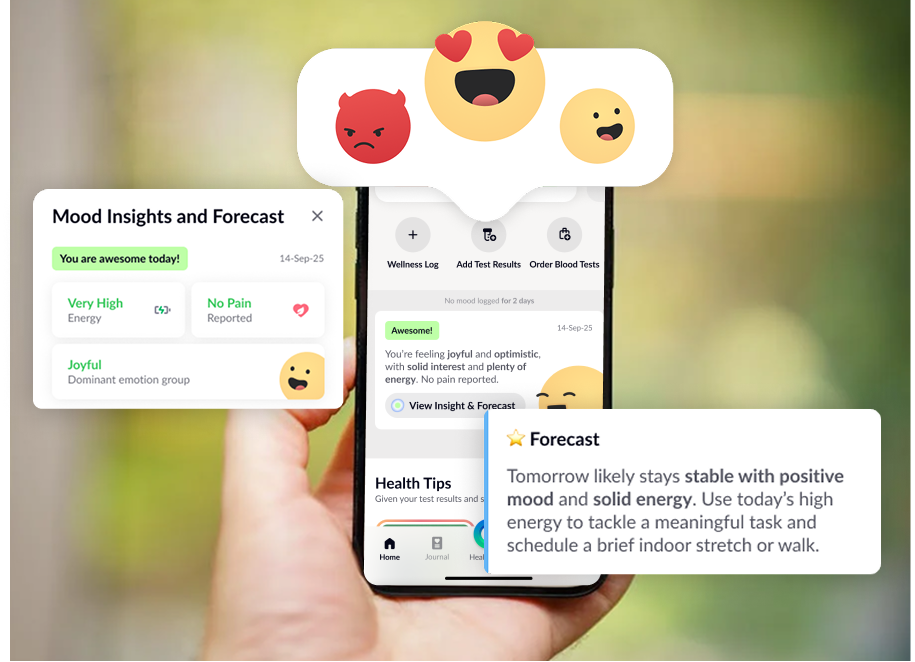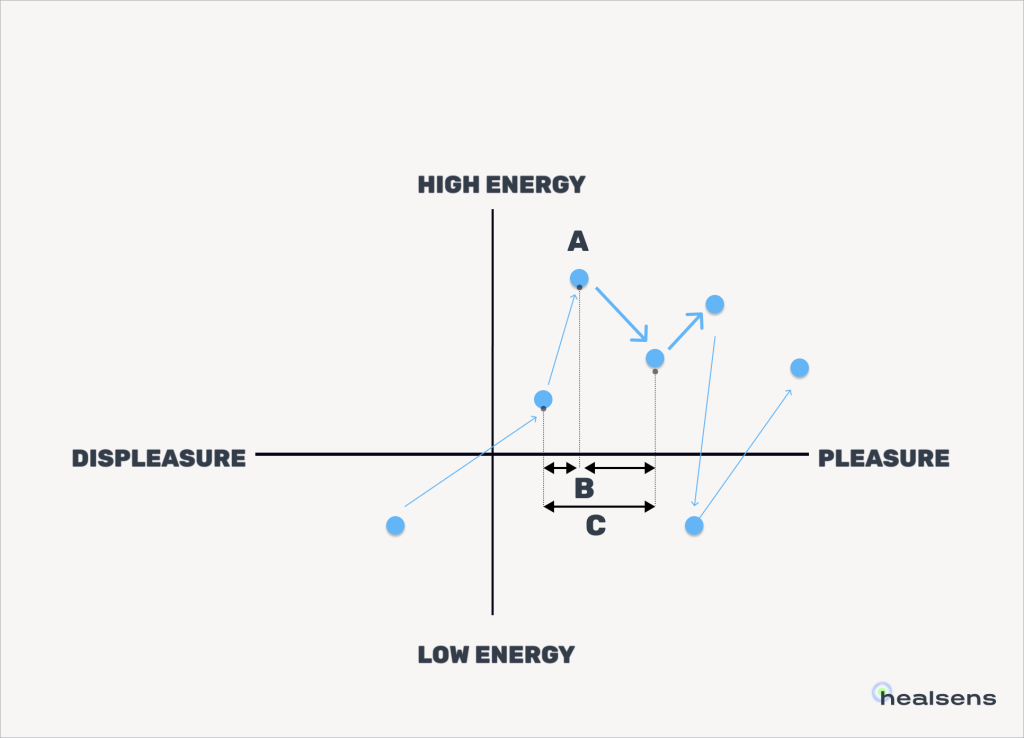3 Traits Every Mood Diary Should Have

A mood diary can be much more than a chart of “good” or “bad” days. When built on a mindful and science-based approach, it becomes a tool for understanding yourself on a deeper level. The right kind of mood diary helps you notice early signs of stress, emotional burnout, and mental overload — while uncovering the habits and factors that sustain your wellbeing.
Let’s explore the three essential traits that make a mood diary truly effective: helping you develop emotional intelligence, recognize emotional patterns, and build resilience against stress.
1. Mood Diary Through Emotions — Learning to Understand Yourself
The foundation of any mood diary lies in the way you assess your emotions. Most apps and journals offer a quick choice of smiley faces to describe how you feel — from “great” to “awful.” This method is convenient because it’s fast and simple. You can often add a short note or select factors that influenced your mood. So, what’s wrong with that?
The problem hides in its very convenience. Choosing a smiley takes only a second — which means you rarely stop to reflect on what you actually feel. Without conscious reflection, you lose the main therapeutic benefit psychologists emphasize: you don’t learn to recognize and name your emotions.
RELATED ARTICLES
Another issue with this quick approach is that people who tend to think in extremes (“everything is great” or “everything is terrible”) will see a distorted emotional picture in their mood diary. Over time, many of them give up tracking altogether because they can’t see the value. To move beyond such superficial evaluation, it’s better to record your mood by choosing specific emotions rather than faces. Why is an emotion-based mood diary more effective?
Imagine trying to describe your “normal” day with a single smiley. You’d probably pick a happy face. But in emotional terms — does “normal” mean calm and peaceful? Or curious and joyful? Maybe it’s closer to tiredness, or even a hint of anxiety?
When you start identifying and naming emotions, you naturally tune in to your body — noticing whether you feel tension, lightness, relaxation, or a subtle tremor. This is what true emotional awareness means: connecting your feelings with your bodily sensations.
It’s also important to notice not only the dominant emotion but the quieter, background ones.
That’s why a good mood diary should not only help you name your emotions but also mark their intensity. That’s when it becomes a tool for genuine self-discovery — allowing you to recognize recurring emotional patterns and understand which emotions you experience most often. These observations can later serve as a valuable foundation for conversations with a psychologist or therapist1.
📍 An emotion journal works as:
– a tool for self-reflection, helping you externalize your experiences, look at them from a distance, and begin an honest dialogue with yourself;
– a way to notice the first signs of emotional burnout before they escalate;
– a practice of emotional acceptance, teaching you to experience and process emotions instead of suppressing them — reducing the risk of anxiety and depression;
– a path to holistic awareness, where over time, your entries stop being just notes of pain or quick judgments and start reflecting the full complexity of your emotional world.
Psychologists call this the development of emotional literacy — the first step toward inner resilience.
» Tired and overwhelmed? Check your allostatic load — the science of stress impact.
2. Energy — The Key to Understanding the Depth of Emotions
Mood is not just about emotions — it’s also about the energy with which those emotions are felt. Anxiety with high energy feels like inner agitation, restlessness, or the urge to act. But anxiety with low energy feels very different — it’s exhaustion, helplessness, or quiet panic when strength is fading.
The same applies to joy: with high energy it becomes excitement and inspiration, while with low energy it transforms into calm contentment.
That’s why it’s so important that your mood diary doesn’t only capture emotions but also helps you notice how energized you are at any given moment. This awareness deepens your emotional understanding and guides you toward the right recovery practices.
When anxiety arises with high energy, your sympathetic nervous system switches to full alert.
Your body perceives the situation as a threat:
– cortisol levels rise,
– adrenaline and insulin flood the bloodstream,
– heart rate accelerates, muscles tighten, the body is ready to fight or flee.
In this state, your body doesn’t need meditation or calming techniques — it needs to release the stored energy. Movement is the best medicine: walking, exercise, deep breathing with long exhales, or any physical activity that helps discharge tension.
But anxiety with low energy is another story. Here, the sympathetic system is drained — cortisol may stay elevated or, conversely, drop too low, while the nervous system shifts into energy-saving mode. You might still feel anxious, but without the strength to act — as if everything has slowed down and your thoughts remain restless, yet you can’t bring yourself to move.
This is your body’s biological signal: your resources are running out.
In this case, physical exertion will only worsen the fatigue. What you need instead is restoration:
gentle breathing practices, meditations such as Kirtan Kriya, supportive social contact, rest, restorative sleep, and nourishing food that replenishes your energy.
📍 Key takeaway:
By tracking how your energy level changes throughout the day, week, or month, you can begin to see when you feel most active and when you’re depleted — and learn to choose the right self-regulation practices.
This kind of awareness, supported by a well-designed mood diary, helps prevent burnout, manage stress mindfully, and restore your internal balance long before your body starts sounding the alarm.
Follow us on Facebook|| Instagram || Telegram || Youtube
3. Turning Observations into a System: The Two-Dimensional Mood Diary Model
Once you’ve learned to recognize and name your emotions (see chapter 1) and to sense your energy level (chapter 2), it’s time to take the next step — to bring structure to your reflections.
The simplest way to start is with a handwritten mood diary. You can use a printed list of emotions — for example, from psychological scales — and record what you feel each day along with your current level of energy. This helps you build awareness and start noticing emotional patterns.
However, the most effective way to track your emotional states is by using a digital mood diary. Modern tools — like the Healsens mood diary or other advanced mood diary apps — are based on two-dimensional models of mood that allow you to assess your emotional state in two key dimensions:
– Valence — how pleasant or unpleasant your emotion feels.
– Energy (Arousal) — how activated or drained you are at the moment.
This structure follows psychologist James Russell’s Circumplex Model of Affect, which demonstrates that emotions cannot simply be classified as “good” or “bad.” What truly matters is how they are experienced.
When you start using a mood diary built on this two-dimensional model, you create your own personal emotional map. Every emotion — from calm satisfaction to anxious excitement — can be placed within this emotional space. By tracking your mood in a mood diary, you can visualize not only peaks and lows but also patterns that repeat over time.
Such insights make your mood diary more than a log of feelings — it becomes a structured system for understanding your emotional life and the subtle dynamics that shape it. With regular use, a mood diary helps transform self-observation into emotional literacy — the foundation of mental stability and resilience.

When you use a mood diary built on this two-dimensional model, you start noticing:
– where your mood tends to stay on the emotional map;
– how much your emotional state fluctuates;
– when you truly rest — and when you simply “switch off.”
Over time, these points form a trajectory of your mood — a line that shows how your emotional state moves through different phases. For some people, the path is smooth and centered in one area; for others, it swings widely across the full range of emotions.
Studies show that these trajectories reflect not only your current wellbeing but also deep personality traits and coping patterns.
A well-designed mood diary helps you see how your emotional and physical states interact, and where the limits of your inner resources truly lie.
📍 Why it matters:
– It helps you distinguish between fatigue and apathy, anxiety and overstimulation, sadness and recovery.
– It reveals when your energy begins to drop, allowing you to adjust your rhythm before burnout sets in.
– It transforms self-observation from merely describing emotions into an active tool for managing your state and understanding your emotional patterns.
By tracking your feelings in a mood diary, you build a bridge between awareness and action — learning not just to record emotions, but to interpret them, respond to them, and ultimately live with greater balance and self-understanding.
» Wondering why you should calculate your biological age? These 5 reasons will convince you to do it now.
🧭 How to Use the Mood Diary in Healsens
In Healsens, the mood diary is part of a holistic view of your health. Each time you record your emotional state on the valence and energy scale, you’re not just tracking your mood — you’re mapping the connection between your body and mind.
Your entries in the Healsens mood diary are integrated with other health data: your sleep quality, noted symptoms or complaints, alcohol intake, and physical activity.
Together, they create a single, unified picture that shows how emotional changes are linked to your lifestyle and physiological state.
📊 Based on this data, Healsens provides personalized micro-recommendations — short, evidence-based tips that gently influence your autonomic nervous system. These can include breathing and meditation practices, movement, aromatherapy, and other scientifically supported self-regulation methods.
If you’d like to explore how using a mood diary can help you manage your emotional state and restore your energy, read our next article.
For now, install the Healsens app — after a short questionnaire, you’ll receive your personalized health checkup plan, because emotional wellbeing is inseparable from physical health.
And you can make your very first mood diary entry today. Exciting, isn’t it?




